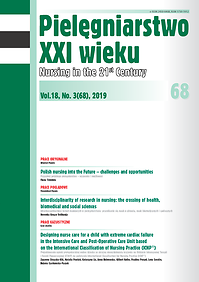Polish anaesthesiology nursing documentation: a complex, multi-faceted nursing practice in the context of evidence-based professional practice
DOI:
https://doi.org/10.2478/pielxxiw-2019-0022Keywords:
nursing documentation, anaesthesiology nurse, patient safetyAbstract
POLISH ANAESTHESIOLOGY NURSING DOCUMENTATION: A COMPLEX, MULTI-FACETED NURSING PRACTICE IN THE CONTEXT OF EVIDENCE-BASED PROFESSIONAL PRACTICE
Introduction.Research demonstrates that nursing documentation is a condition for the continuity of patient care and for their safety. The objective of the article is to present the existing knowledge on anaesthesiology nursing documentation and to specify its essential elements.
Material and methods. A literature review was performed with a systematic literature search. The content of the included studies was analysed in terms of its content and relevance. The materials was gathered through electronic database search.
Results. It was found that the key elements of the documentation-related practice of anaesthesiology nurses were as follows: the record-keeping tool should be adjusted to the clinical practice, the documentation for nurses should take into consideration the patient safety aspect and protect nurses from legal consequences; also, the documentation should comply with the current legal regulations and be regularly updated.
Conclusions. Anaesthesiology nurses who keep their documentation contribute to improving the safety of patients and themselves. With observations and taking notes on all performed interventions, it is possible to prevent errors and track changes in the patient’s condition reflected in their medical record.
References
1. Rozporządzenie Ministra Zdrowia z dnia 16 grudnia 2016 r. w sprawie standardu organizacyjnego opieki zdrowotnej w dziedzinie anestezjologii i intensywnej terapii (Dz. U z dnia 29 grudnia 2016 r. Poz. 2218).
2. Zalecenie Grupy Roboczej do spraw Praktyki w Pielęgniarstwie Anestezjologicznym i Intensywnej Opiece PTPAiIO dotyczące dokumentacji pielęgniarki anestezjologicznej. http://www.ptpaio.pl/dokumenty/5.pdf
3. Alexander EL, Rothrock JC, Mcewen DR. Alexander’s Care of the Patient in Surgery, 2011, 14th. Mosby/Elsevier, St. Louis, MO.
4. Braaf S, Manias E, Riley R. The role of documents and documentation in communication failure across the perioperative pathway. A literature review. International Journal of Nursing Studies. 2011; 48: 1024-1038.
5. Joint Commission (2019) Joint Commission International. Available at: http://www.jointcommission.org/ (accessed 30 January 2019).
6. WHO (2018) Patient Safety. Available at: http://www.who.int/patientsafety/en/(accessed 2 January 2019).
7. International Federation of Perioperative Nurses (2014) Guideline for Developing Standards, Patient Safety – Our Primary Goal. Available at: https://www.inmo.ie/tempDocs/EORNA%20IFPN%20Patient%20Safety.pdf(13 January 2019)
8. AORN Perioperative Nursing Data Set [Homepage of Association of Perioperative Registered Nurses] [Online]. Available at: http://www.aorn.org/education/facilitysolutions/aorn-syntegrity/aorn-syntegrity-standardized-documentation (accessed 17 January 2019).
9. Chappy S. Perioperative patient safety: a multisite qualitative analysis. Association of Operating Room Nurses Journal. 2006; 83: 871-874, 877-888, 891-897.
10. Junttilla K, Lauri S, Salantera S, Hupli M. Initial validation of the perioperative nursing data set in Finland. Nursing Diagnosis. 2002; 13: 41-52.
11. Lee E, Lee M. Comparison of nursing interventions performed by medicalsurgical nurses in Korea and the United States. International Journal of Nursing Terminologies and Classifications. 2006; 17: 108–117.
12. Wilbanks BA. An integrative literature review of contextual factors in perioperative information management systems. Computers, Informatics, Nursing. 2013; 31: 622-628.
13. Rudnik K. Odpowiedzialność prawna i dokumentacja medyczna pielęgniarki anestezjologicznej. Pielęgniarstwo w anestezjologii i intensywnej opiece. 2015; 1(3): 145-148.
14. Rozporządzenie Ministra Zdrowia z dnia 9 maja 2015 roku w sprawie rodzajów, zakresu i wzorów dokumentacji medycznej oraz sposobu jej przetwarzania (Dz. U. z dnia 8 grudnia 2015 r. Poz. 2069).
15. Mellin-Olsen J, Staender S, Whitaker DK, Smith AF. The Helsinki Declaration on Patient Safety in Anaesthesiology. Eur J Anaesthesiol. 2010; 27(7): 592-597.
16. Petrini F, Solca M, De Robertis E, et al.The Helsinki Declaration on Patient Safety in Anesthesiology: a way forward with the European Board and the European Society of Anesthesiology. Minerva Anestesiol. 2010; 76(11): 971-977.
17. Whitaker DK, Brattebø G, Smith AF, Staender SE. The Helsinki Declaration on Patient Safety in Anaesthesiology: putting words into practice. Best Pract Res Clin Anaesthesiol. 2011; 25(2): 277-290.
18. Sorensen EE, Olsen IO, Tewes M, Uhrenfeldt L. Perioperative nursing in public university hospitals: an ethnography. Bio Med Central Nursing. 2014; 13: 1-9.
19. Usselmann E, Borycki EM, Kushniruk AW. The Evaluation og Electronic Perioperative Nursing Documentation Using a Cognitive Walkthrough Approach.2015
20. Yontz LS, Zinn JL, Schumacher EJ. Perioperative nurses’ attitudes toward the electronic health record. Journal of Perianesthesia Nursing. 2015; 30: 23-32
21. Killen AR, Kleinbeck SV, Gollar K, et al. The prevalence of perioperative nurse clinical judgments. Association of Operating Room Nurses Journal. 1997; 65: 101-108.
22. Tiusanen TS, Junttila K, Leinonen T, Salantera S. The validation of AORN recommended practices in Finnish perioperative nursing documentation. Association of Operating Room Nurses Journal. 2010; 91: 236-247.
23. Aholaakko TK. Reducing surgical nurses’ aseptic practice‐related stress. Journal of Clinical Nursing. 2011; 20: 3339-3350
24. Junttila K, Salantera S, Hupli M. Perioperative documentation in Finland. Association of Operating Room Nurses Journal. 2000; 72: 862-866, 868, 870-873.
25. Park HA, Lee HJ, Yoon K. The perioperative nursing data set in Korean: translation, validation, and testing. Association of Operating Room Nurses Journal. 2007; 86: 424-445.
Published
Issue
Section
License
Copyright (c) 2019 Authors

This work is licensed under a Creative Commons Attribution-NonCommercial-NoDerivatives 3.0 Unported License.




